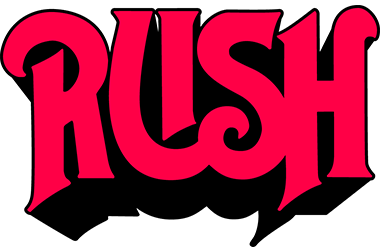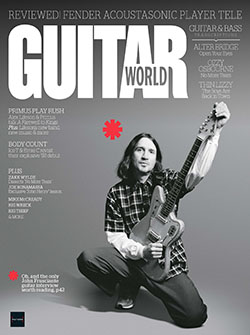
|
-and- New World Man Guitar World Magazine - June 2022 by Joe Bosso (Farewell Tour) and Gregory Adams (New World Man) |
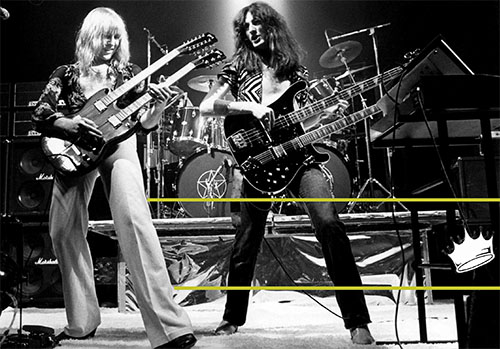
AS PRIMUS PRIME MOVERS LES CLAYPOOL AND LARRY LaLONDE PREPARE TO SET OFF ON A TOUR THAT PAYS TRIBUTE
TO RUSH’S ICONIC 1977 ALBUM, A FAREWELL TO KINGS, THEY CHECK IN WITH GW AND — OF COURSE — RUSH’S ALEX LIFESON.
“HONESTLY, THIS WHOLE THING STARTED AS A
JOKE,” SAYS BASSIST LES CLAYPOOL, EXPLAINING
HOW HE AND HIS PRIMUS BANDMATES —
GUITARIST LARRY “LER” LaLONDE AND DRUMMER
TIM ALEXANDER — BEGAN COVERING RUSH’S
1977 ALBUM A FAREWELL TO KINGS FROM START
TO FINISH. “THEN ONE DAY IT WAS LIKE, ‘HEY,
WAIT. MAYBE THIS ISN’T A JOKE. MAYBE WE
SHOULD ACTUALLY DO THIS.’”
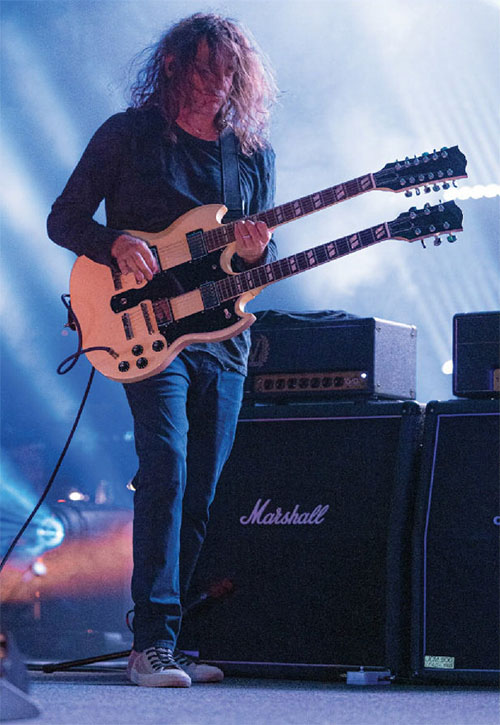 Claypool quickly points out, however,
that at first the band considered paying tribute
to their musical heroes by playing that
album’s follow-up, 1978’s Hemispheres, but
there was one little hitch: “Hemispheres has
‘Cygnus X-1 Book II’ on it,” he says, “and
we couldn’t really go out and play that one
without doing the first one — that would
be a little strange.” For a second or two, the
band even tossed around the idea of covering
Rush’s grand sci-fi classic 2112, but Claypool
thought that such a gesture would be
deemed “too obvious.”
Claypool quickly points out, however,
that at first the band considered paying tribute
to their musical heroes by playing that
album’s follow-up, 1978’s Hemispheres, but
there was one little hitch: “Hemispheres has
‘Cygnus X-1 Book II’ on it,” he says, “and
we couldn’t really go out and play that one
without doing the first one — that would
be a little strange.” For a second or two, the
band even tossed around the idea of covering
Rush’s grand sci-fi classic 2112, but Claypool
thought that such a gesture would be
deemed “too obvious.”
“So we decided to play A Farewell to
Kings,” he says, “which made sense because
it has ‘Cygnus X-1 Book I.’ Plus, that was
the first Rush album I ever heard. I remember
seeing Cygnus as a kid and watching
the Rocinante spaceship flying through the
black hole and just ejaculating in my pants
and thinking, ‘That’s the greatest thing I had
ever seen.’”
Ever since Primus opened for Rush
in 1992, the members of both bands have
remained tight. Recalling his reaction when
he was told that Primus planned to tackle
A Farewell to Kings live, guitarist Alex Lifeson
says, “I thought to myself, ‘I hope Ler
gets those chords right.’” He laughs. “You
know, the song ‘A Farewell to Kings’ has
some quirky chords in it, especially the ones
that are up high on the neck. And with ‘Xanadu,’
I thought, ‘Oh, my God. The poor guy’s
going to be suffering night after night with
that 40-pound guitar on his shoulder.” He
adds, “But seriously, I thought it was great.
What an awesome idea.”
Originally, Primus planned to take their
A Tribute to Kings tour — a full reading of A
Farewell to Kings followed by a set of their
own songs — out on the road in 2020, but
once Covid effectively shut down the global
concert business for the next 18 months,
they were forced to postpone those dates
until last year. Lalonde notes that the unexpected
time spent at home had its benefits.
“To be honest, it meant I could use all of
that free time to actually figure out these
guitar parts,” he says. “Like Alex said, these
songs aren’t that easy to play. I found out
the best way to learn the chords was to simply
email him and ask him what they are.
And that heavy guitar as well [a Gibson EDS-
1275 doubleneck] — I’m using one he sent me,
but I found out he put bricks inside of it. It’s
twice as heavy. There’s bricks inside of it.
I’m sure of that.”
Lifeson lets out a good-natured laugh,
but he doesn’t dispute whether he did or
didn’t add any weight to the guitar. “It feels
that way,” he says.
The 2021 A Tribute to Kings tour was
enthusiastically received by fans of both
bands, so much so that Primus are setting
off on another such excursion this spring,
and for the first time the itinerary will
include stops in Rush’s home turf of Canada.
“I’m glad that people are into seeing
it,” Lalonde says. “It should come as no surprise
that people love these songs, and they
love seeing them being played and hopefully
not butchered too bad — at least myself.
That love is reinforced when I meet people
who come out to the shows. A lot of them
say how emotional it was to see these songs
being played. They’d sing along to them. For
me, it was cool to see how much people love
this band.”
In the following interview, Claypool,
Lalonde and Lifeson discuss Primus’ A Tribute
to Kings tour, and Lifeson reflects on the
recording of the iconic album behind it all.
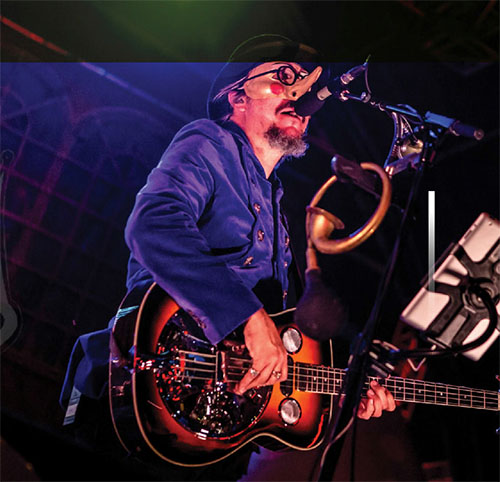 Alex, I’m curious. Did Rush ever play
A Farewell to Kings in its entirety?
Alex, I’m curious. Did Rush ever play
A Farewell to Kings in its entirety?
ALEX LIFESON: I would guess so. I mean,
we did some of the songs.
LES CLAYPOOL: I asked Geddy about this. I
looked this up because I have that big giant
book of all the set lists. You know the one,
right?
LIFESON: Yeah, yeah.
CLAYPOOL: It’s got everything — how much
you guys got paid. The ticket prices are
amazing. I asked Geddy if you guys ever did
“Madrigal” live, and he said no. I’ve never
seen it on a set list.
LIFESON: No. No, there was always one or
maybe two songs we would record knowing
we would never play them live. That
was certainly one of those songs. “Different
Strings” [from Permanent Waves] was
another.
CLAYPOOL: “Madrigal” has become the
song where Ler and I embrace each other on
stage as we perform it. Sensitive, sensitive
tune, you know?
Both bands hit it off when you played
together in 1992. You would even jam
with one another after sound checks,
right?
LIFESON: We did. We would do sound
check at 4:30, and then Primus would set up
and they’d do their sound check. We’d have
dinner at 6, and then we would have a jam,
usually in our dressing room or in a hallway
that was nice and echoey. At one point, the
deal was that you had to go out and get an
instrument you couldn’t play. Ler, I think
you got a clarinet.
LARRY LaLONDE: That’s right.
LIFESON: I got an accordion and a flute.
Weall played these instruments we had
no idea how to play.Weactually recorded
these jams. I don’t know what happened to
those recordings, but we did them everywhere.
When we played in Berlin together,
just after the wall came down, we had a jam
outside around the corner from the parking
lot of the arena. There was a little grassy
area outside the stage door, and I remember
setting up there. Neil had his practice
kit, I think.
LaLONDE: I saw Alex using a tortilla chip
for a guitar pick one time. That was pretty
sweet. [Laughs]
When you say “jam,” what kinds of songs
would you play? What’d it sound like?
LaLONDE: It sounded like somebody asked,
“What would it sound like if someone had
just bought an accordion that day?” That’s
the kind of music it was.
CLAYPOOL: I will say, one of the greatest
things I ever experienced was during one
of those jams in a sports arena locker room
and watching Neil play the lockers as his
percussive instrument. It was amazing.
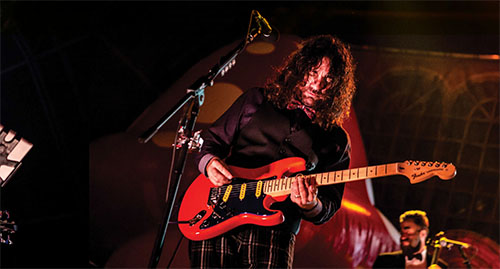 Bearing in mind that the tour is called A
Tribute to Kings, I’m curious if any of you
have seen actual Rush tribute bands.
Bearing in mind that the tour is called A
Tribute to Kings, I’m curious if any of you
have seen actual Rush tribute bands.
CLAYPOOL: On YouTube, I’ve seen — what
are they called — Rash? They’re the one
band that’s pretty popular. I see Geddy
wearing their shirts.
LIFESON: Yeah. He’ll endorse anybody. [Laughs]
LaLONDE: I saw them with the Gillettes.
LIFESON: I haven’t seen any. I don’t really
think about it, to be honest with you. I
guess it’s a nice compliment that someone
would take the time to learn your songs and
play them. I suppose we’ve all been tribute
bands at one time, learning other people’s
songs when we’re starting out. I don’t
know… I don’t really think about it.
It’s a whole different subgenre from what
Primus is doing here. Full-fledged tribute
bands get the whole thing down — the
attire, the way the members look.
LIFESON: Yeah, that’s pretty crazy. I don’t
know why you’d want to look like Geddy. [Laughs]
CLAYPOOL: I already look like Geddy.
[Laughs] I have four silk robes I bought
for this tour.
LaLONDE: Yeah, that’s how you get the
sound.
CLAYPOOL: Exactly. It sounded terrible
until we got the robes.
LIFESON: More scarves.
LaLONDE: Yeah, we need scarves. We’re
deficient in scarves.
What about Primus tribute bands? Les
and Ler, have you checked out any?
LaLONDE: Not really. I think I’ve seen some
clips people have sent me, here and there.
People send me, like, a two-second clip or
something—I’m assuming it’s a cover band
or someone playing a song.
Alex, have you been to any of the Tribute
to Kings shows?
LIFESON: No, I haven’t been out of this
city in two years. I would love to see them. I
think there’s a Toronto date coming up this
summer?
CLAYPOOL: Massey Hall.
LIFESON: Massey Hall’s beautiful. They’ve
just done a major, multimillion-dollar restoration
of the place. I just did a gig there
for Andy Kim.
Have you seen any videos of Primus
from this tour?
LIFESON: No, I haven’t. I’m still trying to
figure out how to work my computer or
iPad. I’m waiting for the real thing. I’m sure
it’s awesome.
LaLONDE: He’s waiting to see me play the
parts wrong in person.
Ler touched on how hard it was to nail
some of the chords in this material. Les,
were there any difficult aspects for you
as well?
CLAYPOOL: Oh, my God, yes. [Laughs] The
vocals were very difficult. I mean, everything
about it’s very difficult— it’s frickin’
Rush! Besides having to put on a big cinder
block of a double neck instrument around
your neck every night… I have to say, I love
playing Primus songs, but every night I
look forward to playing A Farewell to Kings
because it’s just so much fun.
About the vocal parts, I kind of figured
out a little trick of Geddy’s, which I won’t
say, because I think I think it might be a
secret. Finally, my son just said, “Dad, quit
trying to sing it like Geddy. Just do it your
own way.” So I just kind of did that. I have
some stuff that’s sort of in the upper register,
so I would just take on these characters,
like Sgt. Baker [from Primus’ 1991 album
Sailing the Seas of Cheese] … And, of course,
there’s the keyboard parts. But once you’ve
got it, you’ve got it.
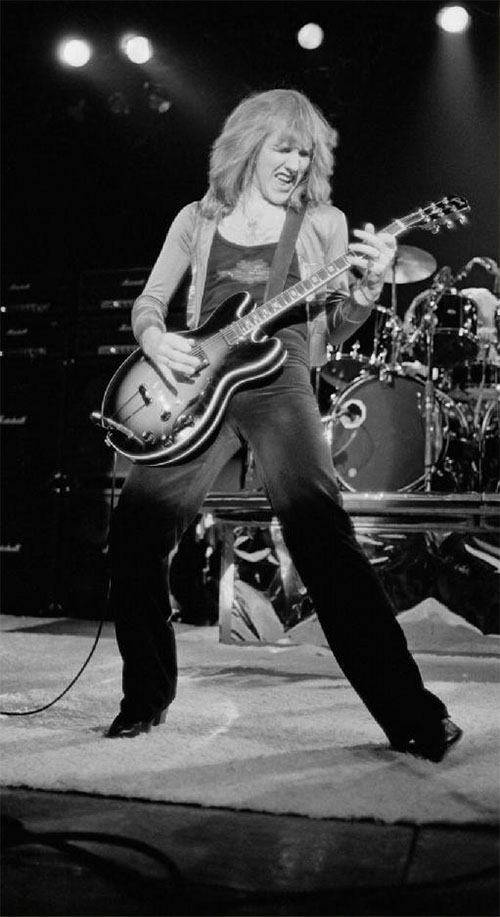 Did playing the same instruments as
Rush used at that time help you feel more
“Rush-like”?
Did playing the same instruments as
Rush used at that time help you feel more
“Rush-like”?
CLAYPOOL: Yes. And the robes! [Laughs]
LaLONDE: For me, it definitely did. One of
the hardest but most fun parts is trying to
switch between the necks. There’s a video
that shows how Alex does it. It’s one of my
favorite parts of the whole night, trying to
get that sweeping across and flipping the
switch back.
LIFESON: You’ve got to be quick.
LaLONDE: You do! But there is a video out
there—I think it’s from Moving Pictures.
There’s one little section I saw where they
show you do it back and forth. I was like,
“Oh, what’s that?” I froze it. I watched it,
like, a hundred times trying to figure it
out. It’s awesome.
Alex, A Farewell to Kings is often cited as
a breakthrough album for Rush. Does it
hold a special place in your heart?
LIFESON: Yeah, it does. I remember when
we were in the studio recording it and the
mood we were all in at the time. We had
done a tour of Britain before the album. It
was the first time we toured there and the
promoter didn’t expect anything, but we
actually did really, really well. We came
back to record the album there, and it was
the first album that we recorded in Britain.
It was really a great experience for us to go
back to the roots of the music we listened to
when we were young. Rockville was a very
cool, very rural kind of studio, not fancy at
all, but it had a good sounding room and a
great sounding console. We had so much
fun recording, as we always did.
And then playing this stuff — “Closer to
the Heart” became quite a big song for us,
and “Xanadu” was always a treat. “Xanadu”
was the first song we recorded, and I
remember we played it once from beginning
to end so that the engineer, Pat Moran,
could get levels. We played it one more
time, and that’s the take that’s on the album.
We did all 11 minutes of it, and Pat was like,
“What?! They switched guitars — what the
fuck?” [Laughs] He was so impressed. And
then we got to the second song, which was
“Cygnus” or something where it was a little
more tedious and more hard work. [Laughs]
Back then we used to prepare. We used to
go into the studio with songs written and
ready to go. And it was certainly one of the
last examples of that.
Any thoughts on doing another Rush
album after this tour?
LIFESON: Uh, no. [Pause] Are you talking
to me?
Oh, no, no! I’m sorry. No, I meant
the Primus guys.
LIFESON: Oh, OK. [Laughs]
CLAYPOOL: I mean, we have to do Hemispheres
at some point in time; at least we’ve
got to do “Cygnus Part II,” just because
you’ve got to finish the sandwich, you
know?
LaLONDE: And I already know how to play
it. One of the ways I learned how to play
guitar was learning all the stuff from Hemispheres.
It’s like, I’d never seen these chords
anywhere before; all my guitar heroes
didn’t play these chords. So that’s how I
learned them.
LIFESON: I’m to help you with those
chords if you need it — if I can remember.
LaLONDE: You’re going to regret that
offer.
New World Man
by Gregory Adams
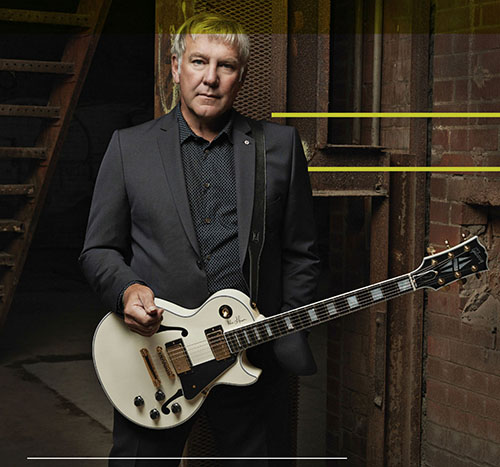 ALEX LIFESON’S PLACE IN MUSIC HISTORY AS
a premiere prog player cannot be understated.
Across five decades with Rush, the
Toronto-based guitarist delivered thrillrides
of dramatic arpeggios, quixotic
whammy-play and irregular hooks galore.
But seven years on from Rush’s final concert
performance — and two since the tragic
loss of drummer/lyricist Neil Peart to glioblastoma,
a form of brain cancer — Lifeson
returns this spring with music from his
much-anticipated, and stylistically divergent
new project, Envy of None. The fledgling
group’s sonic aesthetic is quite a pivot
from what longtime Rush fans may be
expecting from the Canadian guitar hero
— some of the darkly cinematic, synthesized
soundscapes of the quartet’s 11-song,
self-titled effort arguably hew closer to the
moody swerve of Violator-period Depeche
Mode or Nine Inch Nails than the soaring
prog elasticity of, say, “YYZ” or “La Villa
Strangiato.” Though not without its giant
guitar moments, Lifeson’s purview within
Envy of None’s first album was to play with
texture more so than high-flying, trem barheavy
lead work.
ALEX LIFESON’S PLACE IN MUSIC HISTORY AS
a premiere prog player cannot be understated.
Across five decades with Rush, the
Toronto-based guitarist delivered thrillrides
of dramatic arpeggios, quixotic
whammy-play and irregular hooks galore.
But seven years on from Rush’s final concert
performance — and two since the tragic
loss of drummer/lyricist Neil Peart to glioblastoma,
a form of brain cancer — Lifeson
returns this spring with music from his
much-anticipated, and stylistically divergent
new project, Envy of None. The fledgling
group’s sonic aesthetic is quite a pivot
from what longtime Rush fans may be
expecting from the Canadian guitar hero
— some of the darkly cinematic, synthesized
soundscapes of the quartet’s 11-song,
self-titled effort arguably hew closer to the
moody swerve of Violator-period Depeche
Mode or Nine Inch Nails than the soaring
prog elasticity of, say, “YYZ” or “La Villa
Strangiato.” Though not without its giant
guitar moments, Lifeson’s purview within
Envy of None’s first album was to play with
texture more so than high-flying, trem barheavy
lead work.
“I feel like I’ve fully explored the whole
area of soloing,” Lifeson tells Guitar World.
“I think I have a particular style and character
to my solos, [and] there’s lots of variation
in my soloing, but I think at this point
in my life it’s more about servicing the song.
Not being too distracting, or shining a light
on any particular thing. It’s just getting into
the groove, tapping your foot and feeling
connected with the song itself.”
Though Lifeson is excited to be taking
himself in a new sonic direction, Envy of
None’s debut album nevertheless follows
Rush’s staggeringly impressive and iconic
body of work — Canada’s greatest power
trio left a wholly immeasurable imprint
on music fans across 19 full-length albums
and countless mind-bending live performances.
While Lifeson revealed in 2018 —
some 50 years after forming Rush as a teenager
— that the group were basically done,
he clearly hadn’t closed the book on music
altogether. At the time of that announcement,
he’d already been drafting the original
passes of tunes like Envy of None’s
“Kabul Blues,” an evocatively sandy sway
of back-masked guitar tricks and slack,
snapped banjo licks.
“After the last Rush tour in 2015, I made
sure I started writing immediately. I didn’t
want to lose it; I didn’t want to feel like that
was the end. So I continued to write, just for
my own benefit,” he says. “A few of those
tracks are on my website, some of them are
on the Envy of None album.”
As Lifeson was developing song sketches
on his own, longtime friend and bassist
Andy Curran — previously of Toronto hard
rockers Coney Hatch, and a former A&R
person who spent time on the road with
Rush — also approached the guitarist about
playing on a clutch of electronics-spiked
tunes he’d been working on with guitarist/
programmer Alfio Annibalini. Lifeson
agreed, casually sending files back and forth
with Curran for a few years before Portland,
Oregon-based vocalist Maiah Wynne
added her dramatic vibrato to the pieces.
The singer was the X-factor Lifeson and co.
needed to put the band on the front burner.
While initially conceived as an EP, by 2021
Envy of None got serious about their songbook,
ramping up their productivity to produce
a full-fledged album.
“You need to have a focus like this,” Lifeson
suggests of finding inspiration within
Envy of None. “It’s one thing to pick up the
guitar and play for 10 to 15 minutes a day;
it’s another thing to devote a whole day to
recording and developing a part.”
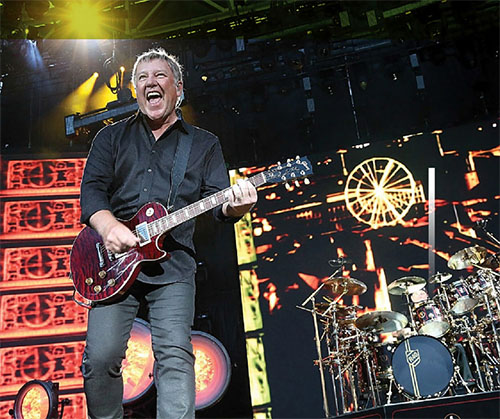 Fittingly enough, Lifeson is explaining
this while seated in front of a couple
dozen guitars hanging from the walls of his
Toronto-area home studio. This includes a
beauty, butterscotch ’52 reissue Telecaster
from 1980 that Lifeson wagers he’d written
“at least 70-80 percent of Rush’s material
on” and a prized 1953 J50 acoustic
that Geddy Lee gave him on his 65th birthday.
The deep brown body of another Tele
was made out of a door that once hung at
the long-gone Le Studio facility in Morin-
Heights, Quebec, where Rush recorded
seven albums between 1980 and 1993.
While sizable, the collection used to be
a whole lot bigger, with Lifeson explaining
that he’d recently sent off 63 guitars to
be sold at auction. Amongst the cull was a
prized white ES-355 he’d picked up from
Gibson’s then Kalamazoo-based factory in
1976, along with a Dove acoustic and a double-
necked 1275. Lifeson refers to the semihollow
ES-355 as the “quintessential Alex
Lifeson guitar” — Gibson had reproduced
the gold-plated character piece as a Lifeson
signature in 2008, though the guitarist
notes that the neck was a bit fatter on
the repro than his Norlin-period original
— and it was featured on every Rush album
from 1977’s A Farewell to Kings through
1996’s Test for Echo. While he was ready to
let go of the guitar, downsizing his collection
ended up affecting him more than he’d
expected.
Fittingly enough, Lifeson is explaining
this while seated in front of a couple
dozen guitars hanging from the walls of his
Toronto-area home studio. This includes a
beauty, butterscotch ’52 reissue Telecaster
from 1980 that Lifeson wagers he’d written
“at least 70-80 percent of Rush’s material
on” and a prized 1953 J50 acoustic
that Geddy Lee gave him on his 65th birthday.
The deep brown body of another Tele
was made out of a door that once hung at
the long-gone Le Studio facility in Morin-
Heights, Quebec, where Rush recorded
seven albums between 1980 and 1993.
While sizable, the collection used to be
a whole lot bigger, with Lifeson explaining
that he’d recently sent off 63 guitars to
be sold at auction. Amongst the cull was a
prized white ES-355 he’d picked up from
Gibson’s then Kalamazoo-based factory in
1976, along with a Dove acoustic and a double-
necked 1275. Lifeson refers to the semihollow
ES-355 as the “quintessential Alex
Lifeson guitar” — Gibson had reproduced
the gold-plated character piece as a Lifeson
signature in 2008, though the guitarist
notes that the neck was a bit fatter on
the repro than his Norlin-period original
— and it was featured on every Rush album
from 1977’s A Farewell to Kings through
1996’s Test for Echo. While he was ready to
let go of the guitar, downsizing his collection
ended up affecting him more than he’d
expected.
“My god, that was one of the most emotional,
difficult things I’ve ever done in my
life. I thought it would be easy. I worked it
all out in my head, but I was a mess when I
did that. The 355 was the last one to go. The
case was wrapped in bubble wrap, and I sat
in the mudroom in my house just holding it,
talking to it and kissing the bubble wrap — it
was pretty pathetic. Then I carried it out to
the truck and said goodbye to it.”
The Envy of None album did, however,
give Lifeson the opportunity for one
last dance with the ES-355, which surges
through chunked-up chord work on the
record’s bruising “Enemy.” Elsewhere, Lifeson’s
prismatic, delay-distanced sculpting
plays a more supportive role, as on first single
“Liar,” one of many moments that crackles
via Curran’s in-your-face fuzz bass. “I
feel like I’m catching a break, to be honest
with you,” Lifeson says of providing textural
“ear candy” while his Envy of None counterparts
step to the forefront.
When it came to the interplay between
he and Annibalini — the latter musician juggling
beatmaking with alt-pop guitar performances
on “Never Said I Love You” — Lifeson
quickly realized he wasn’t there to go
wild on the tracks as a lead player.
He explains: “I got the sense that [Andy
Curran] wanted me to be the guitar player,
but I kept [listening to] Alf’s guitar parts in
‘Never Said I Love You,’ for example, which
is a great, hooky, poppy kind of song. When
I first heard it, I thought, ‘There’s nothing
wrong with the guitars on here; I’m not
going to replace stuff that I don’t need to.’
It’s effective; it’s his style. Maybe I wouldn’t
have played that, but it suits the song and
it’s great. Who am I, a big shot? Forget it.
I’ll just play some nice, big acoustic in the
chorus, lift it up and make it hookier in that
sense. I was perfectly happy with that.”
Throughout the making of Envy of None,
Lifeson was likewise blissing out on the perception-
distorting peel of backwards guitar.
It’s a go-to flavor on the aforementioned
“Kabul Blues,” as well as “Old Strings,” a
striking cosmic ballet. Throughout most of
the track, Lifeson’s volume pedal conjures
elegiac, mock-pedal-steel styling. He shifts
gears in the second verse, though, dovetailing
a Hendrix-inspired ripple of backmasked
licks around Wynne’s softened
vocal, Lifeson envisioning the co-mingling
“as this swirling dance between her and I.”
“Anything that’s backwards sounds
unusual, and if you process it, it sounds even
more unusual,” he elaborates of the aesthetic,
while noting that he’d flipped Wynne’s
vocals to more accurately match her
performance rather than just add some
“random” backwards melody. “I clued in
on that being a more concise way of making
something backwards sound like it’s connected
to the song. It adds so much emotion
and character to the part.”
Gear-wise, Lifeson played around with
plug-ins through most of the effects-heavy
sessions, but he admits to bringing out his
Electro-Harmonix Electric Mistress to
achieve some of Envy of None’s wettest
tones. One guitar that still sits in Lifeson’s
collection is a ’57 Les Paul Goldtop, which
he gloriously puts to use through a dexterously
mountain-scaling set of runs that conclude
“Spy House.”
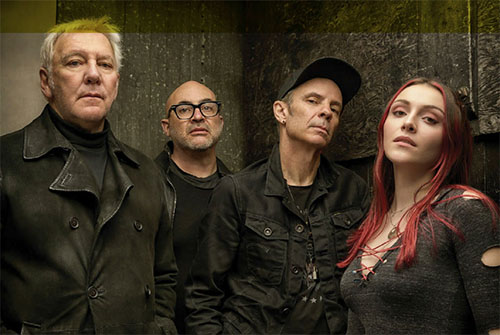 “That was the first song I wrote at the
end of the Rush tour,” Lifeson says. “It has
a solo because it was a natural thing for me
to go into [at the time]—it’s the only solo
on the record, I believe. It was written from
that point of view, [so] it is more guitar-centric.
I mean, I love having those contrasts of
spacey, dreamy stuff happening and a few
moments [like] that.”
“That was the first song I wrote at the
end of the Rush tour,” Lifeson says. “It has
a solo because it was a natural thing for me
to go into [at the time]—it’s the only solo
on the record, I believe. It was written from
that point of view, [so] it is more guitar-centric.
I mean, I love having those contrasts of
spacey, dreamy stuff happening and a few
moments [like] that.”
Beyond the album’s big solo, Lifeson ultimately
found favor weaving his unique guitar
flavor around his Envy of None bandmates,
who also had a hand in reconfiguring
some of Lifeson’s ideas. “Kabul Blues” had
been premiered as a Lifeson instrumental in
the summer of 2021, but was remodeled for
the Envy of None album to include Wynne’s
delay-dripping vocal melodies—Lifeson
also revamped his transcendent wriggling
on the piece to better fit the singer’s aesthetic.
While he’d initially brought a “simplistic”
four-string rhythm to the demo, he
gladly got Curran to provide supple lowend
work on the piece to give it “a bass player’s
sensibility.”
In the case of “Old Strings,” the song initially
existed as an up-tempo number with
a “rootsy sort of swing to it” before Curran
and Annibalini brought down the tempo,
Lifeson hints at the original version being
earmarked for a future solo album from
Wynne. A roots-rustic twist remains on the
LP, however, via the inclusion of closing
number “Western Sunset.” Following the
eerily fuzz-forward, post-industrial pound
of “Liar” or “Enemy,” the burnt ochre
haze of acoustic strums and brushed snare
hits stands as an understated, bittersweet
instrumental, which Lifeson dedicated to
departed friend, Rush bandmate and eternal
drum icon Neil Peart.
“I visited Neil when he was ill,” Lifeson
had previously explained in a press release.
“I was on his balcony watching the sunset
and found inspiration. There’s a finality
about a sunset that kinda stayed with me
throughout the whole process. It had meaning.
It was the perfect mood to decompress
after all these different textures… a nice way
to close the book.”
While the first Envy of None album was
recorded remotely, earlier this year the
quartet convened in Toronto for a listening
party with family and friends—it had
been the first time all four members of Envy
of None has listened to the album together.
Despite this, they didn’t carve out any extra
time to hit up a rehearsal room and work
out the arrangements in-person. Lifeson
suspects Envy of None could start touring at
some point in the future—for that matter,
he also notes that a few song ideas currently
hovering in the digital ether could take
shape eventually. That said, Lifeson is also
quick to note that if Envy of None roll up in
your town, there’s a damned good chance
he’s not the one who’ll be riffing it up alongside
the rest of the band.
“My touring days are over, but we would
certainly put together a group of musicians
that could go on the road with Maiah and
present a really cool show. I would maybe
do a couple of dates here and there [but]
I’m certainly not going to go on the road for
200 days a year on a tour bus,” he says, adding
with a learned, knowing chuckle, “been
there, done it.”
-| Click HERE for more Rush Biographies and Articles |-

